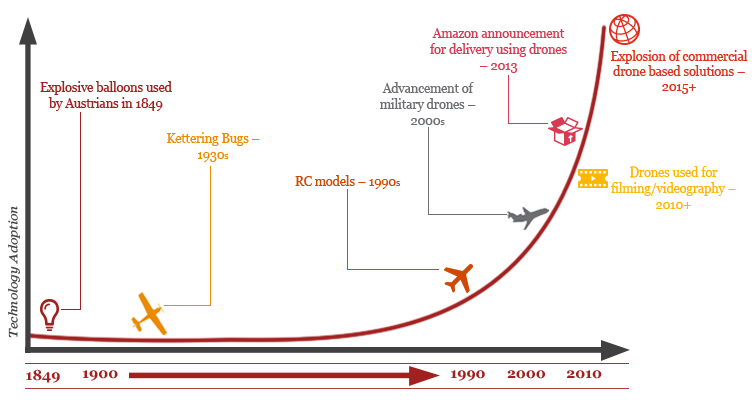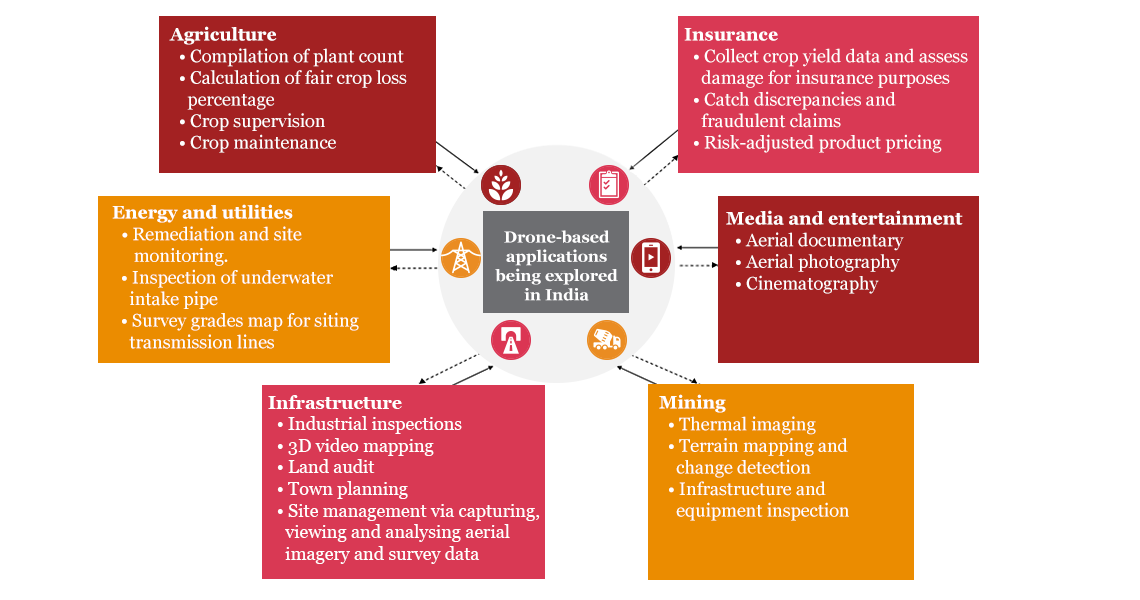Technology advancement follows an exponential growth curve. Every new technology starts off with a few experimental prototypes that generate excitement among the public, but may or may not find widespread adoption. Sluggish growth with incremental improvements is the norm, until an inflection point, caused either due to innovation in core technology or discovery of new applications, leads to exponential growth in adoption.
From the Internet to electric vehicles, we might be in a golden age of technology advancement. The world of unmanned aerial vehicles (UAVs) or drones is no exception. The very first attempts to devise a contraption that could fly on its own were reported back in 1849,1 when Austrians attacked the city of Venice with balloons laden with explosives. If we look for a more modern definition, the first pilotless aircrafts were designed towards the end of the World War I by the US Army: vehicles called ‘Kettering Bugs’2 which were meant to fly as aerial torpedoes using gyroscopic controls to bombard enemy lines. In around the 1930s, the US and British armies independently developed the first radio-controlled (RC) aircraft. Development and usage of such drones continued to be predominantly for warfare by the military. Towards the end of the twentieth century, flying RC aircrafts as a hobby grew substantially, while other non-military commercial applications were also explored by governments and corporations alike away from the public eye.
The drone space reached its inflection point in 2013 when Amazon announced that it would seek to experiment with drones to make deliveries.3 Since then, we have seen an explosion in the usage of drones and drone-based services in the retail and commercial space. Drones are being explored extensively across an array of industries, including, but not limited to, construction, real estate, e-commerce, agriculture, utilities and energy, financial services, and media and entertainment.
Consumer and commercial drones have grown exponentially thanks to merger and rapid advancement in two completely different technologies: radio communication and smartphones. It is elementary that radio communication help in controlling the aircraft, whereas more interestingly, the advent of smartphones has led to a steep reduction in the prices of various equipment like microcontrollers, chips, accelerometers, cameras and other sensors. These have enabled capturing of data, the utility of which is being amplified by the availability of better computing capabilities.
Timeline of drones and exploration of drone-based applications

Exploration of commercial drone solutions – catching up with global trends
The drone space in India is catching up with that in other nations and gaining considerable momentum. According to 6Wresearch, the Indian UAV market is poised to grow at a CAGR of 18%4 during 2017–23 in terms of revenue. Although these numbers will continue to be led by the long range UAV segment, medium and mini-UAVs are also poised to register healthy growth. Data provided by the Stockholm International Peace Research Institute (SIPRI) indicates that with 22.5%5 of the world’s UAV imports, India tops the list of drone-importing nations. Again, these are numbers primarily for military purposes, and commercial drones are showing healthy growth as well. According to study conducted by BIS Research, it is predicted that the market for commercial end-use of drones might supersede the military market by 2021, cumulatively hitting approximately 900 million USD.6
In India, there are six segments across which we have seen drone-based solutions being explored:

Drone-based applications being explored in India
Among these, infrastructure and agriculture are seeing the most traction, in line with global trends:

Addressable market size for drone powered solutions8
Regulations – key to unlocking the full potential of drone-based solutions
For drone-based services to continue to thrive and grow, it is necessary for regulations to be in place. In India, the Director General of Civil Aviation (DGCA) unveiled draft norms for usage of drones in October 2017.7 These are still under review with different ministries in the government and are expected to be formalised in the next couple of years, with further detailing of the policy to be in place by 2025.
A few key highlights of the regulations are:
- UAVs will be classified into five segments based on their weight inclusive of payload.
- All UAVs will have to be registered and provided with a Unique Identification Number (UIN) before they can be operated.
- There will be a set of rules referred to as Civil Aviation Requirements (CAR) that all UAVs will have to adhere to depending on their classification.
- All UAVs can only be flown by trained pilots, training requirements for whom have been detailed.
- Each flight is expected to be tagged and recorded with the data made available to the regulator on demand.
The table below presents the characteristics of the regulatory framework in force today in 16 countries, on five continents. Many countries have yet to develop regulations to guarantee a business-friendly legal environment.
| Territory | Possibility of commercial Flights | Licence required to fly | Training required for pilots in order to obtain licences | Insurance required for commercial flights | Possibility to perform BVLOS flights | License required for BVLOS flights |
|---|---|---|---|---|---|---|
| Poland | ✔ | ✔ | ✔ | ✔ | ✔ | ✔ |
| UK | ✔ | ✔ | ✔ | ✔ | ✔ | ✔ |
| China | ✔ | ✔ | ✔ | ✔ | ✔ | ✖ |
| Canada | ✔ | ✔ | ✖ | ✔ | ✔ | ✖ |
| Germany | ✔ | ✔ | ✔ | ✔ | ✖ | ✖ |
| India | ✔ | ✔ | ✔ | ✔ | ✖ | ✖ |
| France | ✔ | ✔ | ✔ | ✖ | ✔ | ✖ |
| South Africa | ✔ | ✔ | ✔ | ✖ | ✔ | ✖ |
| Indonesia | ✔ | ✔ | ✔ | ✔ | ✖ | ✖ |
| Australia | ✔ | ✔ | ✔ | ✔ | ✖ | ✖ |
| Brazil | ✔ | ✔ | ✖ | ✖ | ✔ | ✖ |
| Mexico | ✔ | ✔ | ✔ | ✖ | ✖ | ✖ |
| USA | ✔ | ✔ | ✖ | ✖ | ✖ | ✖ |
| Japan | ✔ | ✖ | ✖ | ✖ | ✖ | ✖ |
| Russia | ✖ | ✖ | ✔ | ✖ | ✖ | ✖ |
| Argentina | ✖ | ✖ | ✖ | ✖ | ✖ | ✖ |
Regulatory impact is currently one of the most important factors affecting the pace of adoption of drone-powered solutions by business and government entities. Drone regulations have changed in recent years from being treated as a niche hobby to becoming part of regular aviation operations, to a point where national authorities have started developing special regulatory frameworks to address the most urgent issues. The first country to implement all necessary sets of regulations was Poland in 2013. Thanks to the combined efforts of the civilian aviation authorities, the UAV community and insurance companies, Poland allows both visual-line-of-sight (VLOS) and beyond-visual-line-of-sight (BVLOS) operations of commercial drones in a secure and user-friendly way. At the global level, the International Civil Aviation Organization (ICAO), a specialised agency of the United Nations, prepares the standards and recommended practices for national and international air navigation to ensure safe and orderly growth. Of the 191 ICAO members, 63 have some regulations for drones already in place; 9 states have pending regulations and 5 have temporarily banned the use of drones.7
Sources:
1Crilly, R. (20 June 2011). Drones first used in 1848. The Telegraph. Retrieved from https://www.telegraph.co.uk/news/worldnews/northamerica/8586782/Drones-first-used-in-1848.html (last accessed on 20 July 2018)
2Leu, C. The secret history of World War II-era drones. Wired. Retrieved from https://www.wired.com/2015/12/the-secret-history-of-world-war-ii-era-drones/ (last accessed on 20 July 2018)
3Wallace, G. (2 December 2013). Amazon says drone deliveries are the future. CNN Money. Retrieved from https://money.cnn.com/2013/12/01/technology/amazon-drone-delivery/index.html (last accessed on 20 July 2018)
46Wresearch. (21 August 2017). Increasing need for smart avionics and rising defense spending would surge the growth of India unmanned aerial vehicle market. Retrieved from http://www.6wresearch.com/press-releases/india-uav-market-unmanned-aerial-vehicle-share-trends-forecasts-size-growth-opportunity-media-news.html (last accessed on 20 July 2018)
5Bagla, G. (4 May 2015). India leads in import of unmanned aerial vehicles.
6Economic Times. (26 March 2018), India fastest growing market for unmanned aerial vehicles. Retrieved from https://economictimes.indiatimes.com/news/defence/india-fastest-growing-market-for-unmanned-aerial-vehicles/articleshow/63466658.cms (last accessed on 23July 2018)
7DGCA. (n.d.). Requirements for Operation of Civil Remotely Piloted Aircraft System (RPAS). Retrieved from http://www.dgca.nic.in/misc/draft%20cars/CAR%20-%20UAS%20(Draft_Nov2017).pdf (last accessed on 20 July 2018)
8PwC. (2016). Clarity from above. Retrieved from https://www.pwc.pl/pl/pdf/clarity-from-above-pwc.pdf (last accessed on 20 July 2018)












